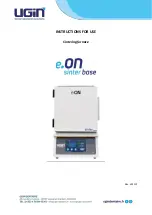
All installations and services must be performed by qualified service personnel.
20
B. GENERAL GUIDELINES TO TROUBLESHOOTING GE ECM – DRIVEN SYSTEMS
:
Disconnect power from unit before removing or replacing connectors, or servicing
motor. Wait at least 5 minutes after disconnecting power before opening motor.
SYMPTOM
CAUSE/PROCEDURE
Motor rocks slightly when starting
This is normal start-up for ECM
Motor won’t start
No movement
Check power at motor
Check low voltage (24 VAC R to C) at motor
Check low voltage connections
(G,PWM,W,R,C,) at motor
Check for unseated pins in connectors on
motor harness
Test with a temporary jumper between R – G
Check motor for tight shaft
Perform motor/control replacement check
Run
Moisture Check
Motor rocks, but won’t start
Check for loose or compliant motor mount
Make sure blower wheel is tight on shaft
Perform motor/control replacement check
Motor oscillates up & down while being
tested off of blower
It is normal for motor to oscillate with no load
on shaft.
Motor starts, but runs erratically
Varies up and down or intermittent
Check line voltage for variation or “sag”
Check low voltage connections
(G,PWM,W,R,C,) at motor, unseated pins in
motor harness connectors
Check “Bk” for erratic CFM command (in
variable speed applications)
Check-out system controls – T’stat?
Perform Moisture Check
“Hunts” or “puffs” at high CFM (speed)
Does removing panel or filter reduce
“puffing”?
Reduce restriction
Reduce max airflow
Stays at low CFM despite system call for
cool or heat CFM
Check low voltage (T’stat) wires and
connections
Verify fan is not in delay mode – wait until
delay complete
“R” missing/not connected at motor
Perform motor/control replacement check
Stays at high CFM
“R” missing/not connected at motor
Is fan in delay mode? – wait until delay time
complete
Perform motor/control replacement check
Blower won’t shut off
Current leakage from controls into G,Y or
W? Check for Triac switched t’stat or solid
state relay





































